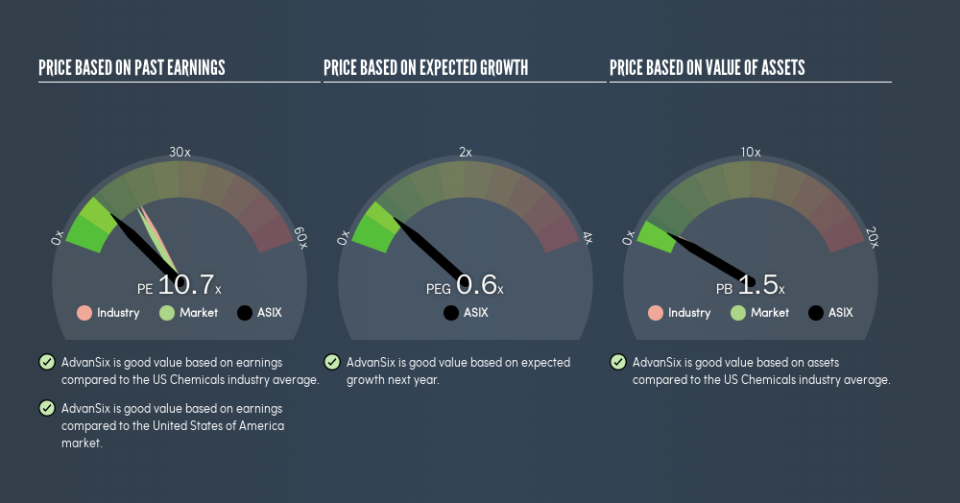Here's What AdvanSix Inc.'s (NYSE:ASIX) P/E Ratio Is Telling Us

Today, we'll introduce the concept of the P/E ratio for those who are learning about investing. To keep it practical, we'll show how AdvanSix Inc.'s (NYSE:ASIX) P/E ratio could help you assess the value on offer. AdvanSix has a P/E ratio of 10.66, based on the last twelve months. In other words, at today's prices, investors are paying $10.66 for every $1 in prior year profit.
See our latest analysis for AdvanSix
How Do You Calculate A P/E Ratio?
The formula for P/E is:
Price to Earnings Ratio = Share Price ÷ Earnings per Share (EPS)
Or for AdvanSix:
P/E of 10.66 = $22.57 ÷ $2.12 (Based on the trailing twelve months to June 2019.)
Is A High Price-to-Earnings Ratio Good?
A higher P/E ratio implies that investors pay a higher price for the earning power of the business. That isn't a good or a bad thing on its own, but a high P/E means that buyers have a higher opinion of the business's prospects, relative to stocks with a lower P/E.
Does AdvanSix Have A Relatively High Or Low P/E For Its Industry?
The P/E ratio indicates whether the market has higher or lower expectations of a company. The image below shows that AdvanSix has a lower P/E than the average (18.9) P/E for companies in the chemicals industry.
AdvanSix's P/E tells us that market participants think it will not fare as well as its peers in the same industry. Since the market seems unimpressed with AdvanSix, it's quite possible it could surprise on the upside. You should delve deeper. I like to check if company insiders have been buying or selling.
How Growth Rates Impact P/E Ratios
When earnings fall, the 'E' decreases, over time. That means even if the current P/E is low, it will increase over time if the share price stays flat. So while a stock may look cheap based on past earnings, it could be expensive based on future earnings.
AdvanSix saw earnings per share decrease by 52% last year. And it has shrunk its earnings per share by 6.2% per year over the last three years. This might lead to low expectations.
Remember: P/E Ratios Don't Consider The Balance Sheet
It's important to note that the P/E ratio considers the market capitalization, not the enterprise value. So it won't reflect the advantage of cash, or disadvantage of debt. The exact same company would hypothetically deserve a higher P/E ratio if it had a strong balance sheet, than if it had a weak one with lots of debt, because a cashed up company can spend on growth.
Spending on growth might be good or bad a few years later, but the point is that the P/E ratio does not account for the option (or lack thereof).
Is Debt Impacting AdvanSix's P/E?
AdvanSix has net debt equal to 38% of its market cap. While it's worth keeping this in mind, it isn't a worry.
The Verdict On AdvanSix's P/E Ratio
AdvanSix has a P/E of 10.7. That's below the average in the US market, which is 17.4. With only modest debt, it's likely the lack of EPS growth at least partially explains the pessimism implied by the P/E ratio.
Investors have an opportunity when market expectations about a stock are wrong. If the reality for a company is not as bad as the P/E ratio indicates, then the share price should increase as the market realizes this. So this free visualization of the analyst consensus on future earnings could help you make the right decision about whether to buy, sell, or hold.
Of course you might be able to find a better stock than AdvanSix. So you may wish to see this free collection of other companies that have grown earnings strongly.
We aim to bring you long-term focused research analysis driven by fundamental data. Note that our analysis may not factor in the latest price-sensitive company announcements or qualitative material.
If you spot an error that warrants correction, please contact the editor at editorial-team@simplywallst.com. This article by Simply Wall St is general in nature. It does not constitute a recommendation to buy or sell any stock, and does not take account of your objectives, or your financial situation. Simply Wall St has no position in the stocks mentioned. Thank you for reading.

